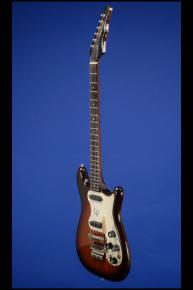A Near Mint Mid-Sixties Two Pick-Up Epiphone Olympic.
1965 Epiphone Olympic SB 722D.
This fine and very light guitar weighs just 5.60 lbs. Thirteen inch wide asymmetrical double cutaway, one-piece solid mahogany contoured body with a waist contour. One-piece mahogany neck with a fast thin-to-medium profile. Black faced 'Batwing' headstock with "Epiphone" silk-screened in gold. Bell-shaped two layer black over white plastic truss-rod cover with two screws. Rosewood fretboard with 22 original jumbo frets and pearl dot markers. Serial number "323241" stamped in blind on back of headstock. Six-in-a-row 'double-line' Kluson Deluxe tuners with white plastic oval buttons. The scale length is a standard Gibson 24 3/4 inches and the nut width is just over 1 9/16 inches. Two Melody Maker single-coil pickups with nice, balanced outputs of 6.97k and 7.09k. Single-layer white plastic pickguard with inlaid silver Epiphone 'Epsilon' and eight screws. Four controls (two volume, two tone) plus three-way selector switch and jack socket, all on pickguard. Black plastic ribbed-sided knobs with metal tops with red markings. The potentiometers are stamped "134 6508" & "134 6523" (Centralab February & June 1965). Combination ridged "wrap-over" bridge, factory Epiphone Vibrola tailpiece with tubular tremolo arm with walrus-tooth tip. There is a minimal amount of belt-buckle scarring on the back and a few very small surface marks , mainly on the edges. This fine little, all original mid-sixties guitar is in exceptionally fine (9.00) condition). Housed in a later 3-latch black softshell case with blue felt lining (8.50)
According to a 1965 Epiphone price, list this guitar sold for $189.50.
"The solidbody line got a complete overhaul that gave the models as much first-impression power as the new sharp-pointed, double-cutaway Gibson SG models. The Epis had been slimmed down almost immediately after their introduction to a body depth of only 1 3/8", with rounded body edges…" (Walter Carter. Epihone, The Complete History, p. 68). The asymetrical, double-cutaway sunburst Olympic body style was introduced in 1963 and by 1964 the headstock had been changed to the 'Batwing' style with six-on-one-side tuners and a Maestro vibrola tailpiece was optional. By 1965 the Maestro vibrola was standard. In 1966 the optional cherry finish was introduced. The Epiphone Olympic was discontinued in 1970.











